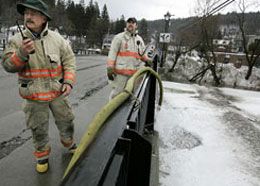By Chief Willis Carter
Communications Chief, Shreveport, La., Fire Department
President of the Association of Public-Safety Communications Officials International
 AP Photo/Alden Pellett |
Communications is the central nervous system of public safety. It includes not only the initial call for help taken by our call takers, but the rendering of appropriate services and monitoring of our field personnel by our dispatchers. In addition, it is a way for responders to communicate with each other about potential dangers on the scene, a life-saving service provided by the equipment we take for granted every day.
As we have seen, the inability of many emergency personnel to talk to each other — or operate — over common systems can have life-and-death consequences. Too often emergency responders from different agencies arriving at the scene of an emergency can’t communicate with each other. The lack of interoperability between police and fire was a direct contributor to the deaths of 343 firefighters on September 11, 2001.
Communications issues are not limited to a lack of interoperability and these issues are not just in the big cities or during major disasters. It is a problem virtually everywhere in the United States., and during incidents as routine as traffic accidents, where emergency medical services (EMS), fire and law enforcement often respond together.
All of these issues are finally getting the attention they need to ensure the safety of our responders and our citizens. Although we are glad to have some attention focused on our issues and the opportunity to resolve some of them, this spotlight has made the task of purchasing communications equipment a bit daunting with all of the considerations that need to be made.
Here are some of the main things to consider when purchasing communications equipment for the fire services.
Dual-head mobile radios for engineers and ladder operators
Mobile radios installed in apparatus should be easily accessible to both officer and driver. Large displays and controls that can be easily manipulated wearing gloves or in low-light situations are a must. Apparatus with outside-the-cabin operations such as ladder trucks, mini-pumpers, engines and tankers should have mobile radios with dual-head capability for access by the engineer or ladder operator. This second control head should be located on or near the pump panel or ladder controls and be equipped with noise canceling headphones and microphones.
Noise canceling mics
Due to the high level of ambient noise on any emergency scene, mobile and portable radios should be equipped with noise canceling microphones and, where possible, noise canceling headphones. This eliminates a majority of noise from equipment operations and other on-scene activities.
The International Association of Fire Chiefs (IAFC) recently released a report on fireground noise and digital radio transmissions and includes recommendations for standards and guidelines for scenario-based training on communications equipment and information on analog vs. digital radio technology. The report can be found on the IAFC Web site at http://www.iafc.org/associations/4685/files/digProj_DPWGinterimReport.pdf.
Portable radios for trucks
In compliance with NFPA Standard 1221, which requires one spare portable radio for every 10 units in service, apparatus should be equipped with spare portable radios for use on scene during operations. These radios provide communications capabilities to emergency personnel on-scene that may not have an assigned radio such as in departments that issue portable radios only to officer or command positions. It also allows departments to issue a radio on scene to other emergency responders that may not have access to the primary radio frequency being used during the incident which enhances radio interoperability.
The NFPA sets numerous other standards for communications equipment and departments purchasing new equipment should do their homework and make sure the equipment they are purchasing meets these standards.
Radios specs
All portable radios should be equipped with a “May Day” or emergency alert button that is easily accessible but recessed to prevent accidental activation and an identifier that transmits an identification code with each transmission specific to that unit. In addition, portable radios should be intrinsically safe for the environment where they are being operated. Portable radios should also be equipped with a paging option that allows the radio to serve as a radio pager for receiving tone alerts for alarms or for emergency evacuation procedures on scene.
In-building coverage
Departments in urban areas need to address radio coverage inside buildings when seeking to purchase radio equipment. This includes specifying a “talk-in/talk-out” coverage percentage for specific structure types such as wood frame, commercial or concrete. Talk-out and talk-in refer to the field unit’s abilities to receive transmissions from their radio system and to access the system and transmit. These percentages should be as equal as possible for best coverage. Urban departments may also need to research the need for in-building repeater systems or enhanced antenna systems for large structures such as hospitals, arenas, convention centers, malls or other large buildings with high-response rates.
This is by no means a comprehensive list, but it should help you get started. As first responders, we have the most important job of protecting the citizens, residents and visitors of our respective communities and the most important part of this job is staying informed on the issues within our industry.
- Any other suggestions? Anything we missed in the list above? Leave a comment below or e-mail products@firerescue1.com with your feedback.
The Association of Public-Safety Communications Officials (APCO) International is the world’s oldest and largest professional organization dedicated to the enhancement of public safety communications. APCO International serves the professional needs of its 15,000 members worldwide by creating a platform for setting professional standards, addressing professional issues and providing education, products and services for people who manage, operate, maintain and supply the communications systems used by police, fire and emergency medical dispatch agencies throughout the world. For more details, visit APCO911.org.


